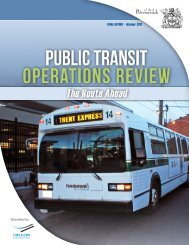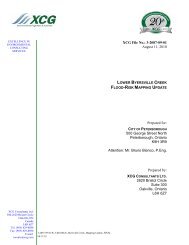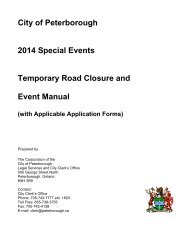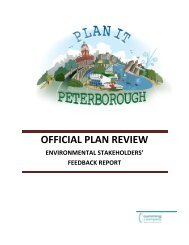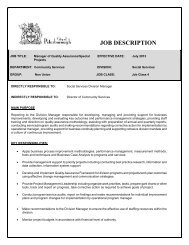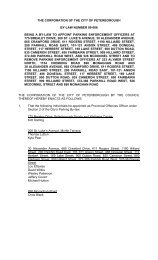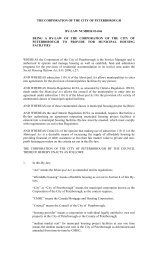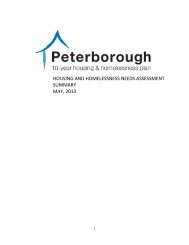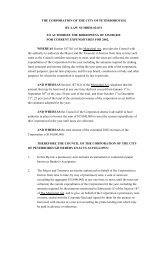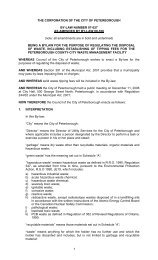Thompson Creek Flood Study Report - City of Peterborough
Thompson Creek Flood Study Report - City of Peterborough
Thompson Creek Flood Study Report - City of Peterborough
You also want an ePaper? Increase the reach of your titles
YUMPU automatically turns print PDFs into web optimized ePapers that Google loves.
<strong>Thompson</strong> <strong>Creek</strong> Detailed <strong>Flood</strong> Reduction <strong>Study</strong><br />
<strong>City</strong> <strong>of</strong> <strong>Peterborough</strong><br />
4.7 FLOOD DAMAGE ESTIMATION<br />
One <strong>of</strong> the factors considered in deciding whether to proceed with flood protection<br />
measures for flood vulnerable areas is the economics <strong>of</strong> the project. Generally, a<br />
benefit-cost analysis is completed to evaluate whether the dollar value flood damages<br />
prevented by flood protection exceeds the capital and operating costs <strong>of</strong> the project.<br />
Many other factors must be considered such as environmental issues and social issues<br />
but the benefit-cost relationship is generally an important decision factor.<br />
To estimate the benefit side <strong>of</strong> the “equation,” a method <strong>of</strong> assessing the dollar value <strong>of</strong><br />
flood damages must be identified and applied. The result is generally a value known as<br />
the Present Value (PV) <strong>of</strong> the average annual flood damages (AAFD). It can be<br />
directly compared with the sum <strong>of</strong> the capital cost and present worth <strong>of</strong><br />
operation/maintenance <strong>of</strong> any protection works. The approach used to estimate the PV<br />
<strong>of</strong> the AAFD is generally as follows:<br />
1. The extent <strong>of</strong> flooding is identified for different return periods (e.g. 1 in 2 year,<br />
1 in 5 year, 1 in 10 year, 1 in 25 year, 1 in 50 year and 1 in 100 year).<br />
2. Any assets affected by the flooding are identified for each return period and an<br />
estimate <strong>of</strong> the $ damages which each would suffer under those conditions is<br />
assessed. Generally more assets will be affected by larger events. Hence the $<br />
damages will increase with the return period <strong>of</strong> the event.<br />
3. The AAFD is calculated by weighting the estimated damage for each return<br />
period by its probability <strong>of</strong> occurrence, e.g. using the six return periods noted<br />
above, the AAFD would be:<br />
AAFD = 0.5 * D2 + 0.2 * D5 + 0.1 * D10 + 0.04 * D25 + 0.02 * D50 + 0.01 * D100<br />
where Dn is the $ damage associated with the return period n<br />
and the weighting factors 0.5, 0.2, etc. are the inverse <strong>of</strong> the return<br />
period, e.g. 1/2, 1/5, 1/10, etc.<br />
4. The present value is calculated using an accounting formula which converts an<br />
infinite stream <strong>of</strong> annual values to a present worth using a discount factor.<br />
It is worth noting that in calculating the AAFD, less frequent events have relatively<br />
little impact on the total since their weighting is so small compared to more frequent<br />
events. For example, any damages occurring for a 100 year storm have one 50 th <strong>of</strong> the<br />
weight for damages from a 2 year event. This means that it is not necessary to evaluate<br />
14-06605-01-W01 <strong>City</strong> <strong>of</strong> <strong>Peterborough</strong> 88




